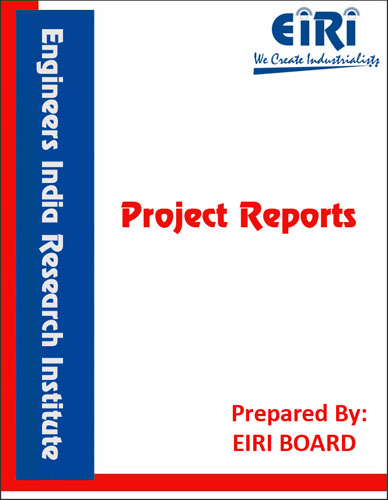The project report includes Present Market Position and Expected Future Demand, Market Size, Statistics, Trends, SWOT Analysis and Forecasts. Report provides a comprehensive analysis from industry covering detailed reporting and evaluates the position of the industry by providing insights to the SWOT analysis of the industry.
Kaolin, also known as china clay, is a natural clay formed by chemical weathering of aluminium silicate minerals like felspars through a complex sequence of events. It is relatively pure clay predominantly consisting of kaolinite (Al2Si2O5(OH)4), associated with other clay minerals like dickite, halloysite, nacrite and anauxite. Kaolin is commercially valued for its whiteness and fine particle size which distinguish it from other clays, such as, ball clay and fireclay. Other physical characteristics that influence commercial utility include brightness, glossiness, abrasiveness and viscosity. It often contains small amounts of impurities in the form of rock fragments, hydrous oxides and colloidal materials. Kaolin is produced and consumed in the country in crude & processed forms. The major use of crude china clay in is in Cement Industry and of processed china clay is in Ceramic Industry. The insitu clay deposits in India is often soft and easily extracted with no blasting required.
China clay owes its name to the fact that originally it was used in china under the name Kaolin; for the production of fine white procelain. China clay or Kaolin is a microcrystalline hydrated silicate of aluminium, approximately Al2O3, 2SiO3, 2H2O, corresponding to 46 percent of silica, 40 percent of alumina and 14 percent of water commercial grades generally contents small amounts of quartz, oxides of iron and titanium, oxides and silicate of calcium and magnesium, potash and soda.
This clay is formed as the result for the decomposition of granite in situ granite is an igneous rock composed of associated crystals of mica, quartz feldspar, the latter consisting essentially of slicates of alumina, with variable proportions of silicates of potash, soda or lime under the prolonged influence of weathering and exposure to water and carbon dioxide under great pressure the feldspar crystals are decomposed, the soda or potash being extracted, leaving the hydrated silicate of alumina. This process known as kaolinisation, converts the granite into a friable mass of clay mixed with the under decomposed crystals of quartz and mica, and the quantity of china clay depends on the completeness with which the alkalies, iron and other constituents have been leached out during the decomposition.
Clay material is composed of extremely small particles of clay minerals. These mineral are generally crystalline but in some cases their organization is so poor that diffraction indicates them to be amorphous clay minerals are essentially hydrous aluminium silicates with iron or magnesium proxying wholly or in part for the aluminium with alkali or alkaline earths present as essential constituets besides some non-clay constituents like feldspar quarts & calcite.
For use in the paint and other industries, china clay is obtained by directing high pressure jets of water on the faces of clay deposits. Where by a watery and sludge is formed from which the heavy impurities in the clay separates out, the sludge passes on to further settling tanks where further coarse, mica, ceouse particles settles cut. The refinement process consists for washing, settling and filtering and ends with the production of a wet cake of purified clay which is then broken down, dried in hot kilns and dry-ground for dispatch to the users.
Sources of supply of china clay are widespread, largest producer being the United States, United Kingdom, France, Germany, Czechoslovakia and India (Jaipur). In our country this is also available in abundance.
INTRODUCTION
PROPERTIES
GRADES OF CHINA CLAY
GRADE -2 MICRONIZED (FINALLY GROUND) 32 MICRON
PROPERTIES OF CHINA CLAY
B I S SPECIFICATION
INDUSTRIAL USES
REQUIREMENT AND PACKAGING OF CHINA CLAY
TESTING METHOD FOR CHINA CLAY
MARKET POSITION AND SCOPE
PRODUCTION OF KAOLIN
CONSUMPTION OF RAW CHINA CLAY
GLOBAL MARKET POSITION OF KAOLIN
PRODUCERS OF KAOLIN
PRESENT MANUFACTURERS OF CHINA CLAY
MINING AND PROCESSING OF CHINA CLAY
METHOD OF CHINA CLAY PROCESSING
PROCESS FLOW DIAGRAM
PROCESS OF MANUFACTURE
FLOW CHART
PLANT LAYOUT
PRINCIPLES OF PLANT LAYOUT
PLANT LOCATION FACTORS
EXPLANATION OF TERMS USED IN THE PROJECT REPORT
PROJECT IMPLEMENTATION SCHEDULES
SUPPLIERS OF RAW MATERIALS
SUPPLIERS OF PLANT AND MACHINERY
SUPPLIERS OF PLANT AND MACHINERY (IMPORTED)
APPENDIX – A :
1. COST OF PLANT ECONOMICS
2. LAND & BUILDING
3. PLANT AND MACHINERY
4. FIXED CAPITAL INVESTMENT
5. RAW MATERIAL
6. SALARY AND WAGES
7. UTILITIES AND OVERHEADS
8. TOTAL WORKING CAPITAL
9. COST OF PRODUCTION
10. PROFITABILITY ANALYSIS
11. BREAK EVEN POINT
12. RESOURCES OF FINANCE
13. INTEREST CHART
14. DEPRECIATION CHART
15. CASH FLOW STATEMENT
16. PROJECTED BALANCE SHEET



